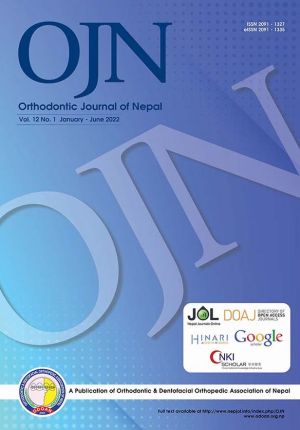Comparison of Pharyngeal Airway Width among Individuals having Skeletal Class I Malocclusion with Different Growth Patterns
DOI:
https://doi.org/10.3126/ojn.v12i1.47485Keywords:
McNamara, Pharyngeal airway, Skeletal class IAbstract
Introduction: An interaction can be seen between respiratory function and the maxillary growth pattern. Therefore, this study was conducted to assess and compare the pharyngeal airway width of individuals with different growth patterns in skeletal class I malocclusion.
Materials and Method: Analytical cross-sectional study was done to assess total of 60 cephalometric radiographs of individuals with skeletal class I malocclusion pattern selected through convenience sampling method. McNamara analysis was done to measure the width of upper and lower pharyngeal space. Statistical analysis was done in SPSS version 20. One way ANOVA and Post Hoc test were done to determine the mean difference of upper and lower pharyngeal airway space width in between individuals of skeletal class I malocclusion with different growth pattern.
Result: There was no significant mean difference in upper pharyngeal airway space (p=0.201) seen in between three growth patterns of individuals with class I malocclusion. However, the study participants with vertical growth pattern showed significantly less lower pharyngeal space width (8.36±2.63mm) than in horizontal growth pattern (10.89±3.46 mm, p=0.028).
Conclusion: The findings of this study conclude that in skeletal class I malocclusion, there is no difference in upper pharyngeal space dimensions among individuals with different growth patterns but the vertical growth pattern shows smaller dimension of lower pharyngeal space than horizontal growth pattern.
Downloads
Downloads
Published
How to Cite
Issue
Section
License
Copyright (c) 2022 Orthodontic & Dentofacial Orthopedic Association of Nepal

This work is licensed under a Creative Commons Attribution 4.0 International License.
Copyright © held by Orthodontic & Dentofacial Orthopedic Association of Nepal
- Copyright on any research article is transferred in full to the Orthodontic & Dentofacial Orthopedic Association of Nepal upon publication in the journal. The copyright transfer includes the right to reproduce and distribute the article in any form of reproduction (printing, electronic media or any other form).
- Articles in the Orthodontic Journal of Nepal are Open Access articles published under the Creative Commons CC BY License (https://creativecommons.org/licenses/by/4.0/)
- This license permits use, distribution and reproduction in any medium, provided the original work is properly cited.




